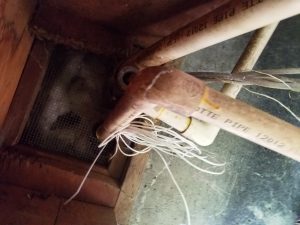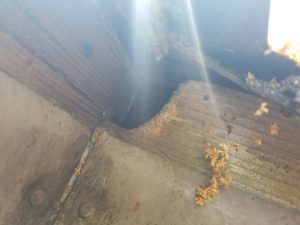Ampm Extermination exterminators can handle the toughest rat mice control removal situation. Rats & Mice are usually classified as a pest species due to their habits of living in building. Rats Mice living in the attic; Rats Mice scratching in the walls; Rats Mice getting in the pantry; Gnawing on electrical wires; Concerns over health risks. Identifying how they are getting into the home, get them out and then create a custom Rats mice exclusion plan to keep them out.

Home Commercial Pest Extermination Exterminators for Rats Mice Control: Mouse Trapping & Removal Service
Keeping a clean and uncluttered house is a great way to deter numerous pests, including mice. Vacuum carpets to get rid of crumbs, spills, and everyday debris that attract mice. The clutter in your garage, basement, closets, or attic can make an inviting home for mice.
Mice like to Live Near Humans. The house mouse lives most often in close proximity with humans, including in and around homes, barns, granaries, and fields, or any place where food is readily available. Typically, a mouse nest is made from soft materials like rags and shredded paper or cardboard.
How Mice Enter Homes.  Mice enter homes through cracks and holes found in walls, floors and foundations. Homeowners commonly do not recognize mouse holes until other signs of infestation appear. In order to prevent mice from entering the home, all cracks, openings and holes should be sealed with metal or cement.
Mice enter homes through cracks and holes found in walls, floors and foundations. Homeowners commonly do not recognize mouse holes until other signs of infestation appear. In order to prevent mice from entering the home, all cracks, openings and holes should be sealed with metal or cement.
Attic Crawlspace Clean up disinfection reinstallation of damaged insulation.
Sanitation is critical to rodent control. Rats Mice require less food, do not require water daily. Rodents, mice rats are problematic inside of any structure. While rodent issues will generally be more pervasive in areas where construction may be older, sanitation may not be ideal, rodents can infest any building. Recognition of a mouse or rat problem is not necessarily a reflection on one’s tidiness or cleanliness. Mice, rats, other rodents can carry health concerns such as rabies, hantavirus, or even bubonic plague. You also need to remove them for the sake of your health. Raccoons in particular can wreak havoc in your attic just as rats’ mice like to nest inside your walls, furniture, pantry.
What does a rat exterminator do?
Mice Mouse Extermination should be able to fix all of the structural issues that made it possible for the rats to get into your home. Mice and rats love warm places with a steady food supply and protection from the elements; hence, their decision to make a home in your house. Rodents like these carry potential diseases.
The house mouse usually makes a nest in stored materials indoors, but can also live outside, burrowing in areas around fields and lawns. Mice often become a problem in the fall when they enter homes to seek warmth. Mice tend to nest only 10 to 20 feet from their food supply. Hiring Commercial pest control is a better bet if you are not familiar with rodent extermination.
Why do rats nest in the attic?
Roof rats are a species of rodent house rat or mouse that usually nest above ground in trees or tall shrubs, so their indoor nests are just as likely to be in upper levels of the home or business building. Rats leave a ton of droppings in an attic which are 1/3-inch brown or black thick grains of rice or even bigger depending on the food supply they have access to, very similar to squirrel droppings.
Rats Mice in attic and crawlspaces also leave tunnels and trailways in the insulation. They also leave chew marks, they leave brown smudges from grease in their fur, and these lines the commonly travelled rat routes. You might see chew marks, on pipe insulation, wood, or electrical wires.
How to Trap a Rat – Mice Trapping to Catch Rats
Commercial Professional Rat Removal Companies exterminators always place traps where the rats are. Signs of nesting, gnawing, and droppings is a good area to Place the traps right up against the wall in secluded areas where they are seeking shelter and along the runways and trails the rats are traveling.
How come catching and killing rats and mice is difficult
The very first thing that has to be done is to make sure More rats and mice are not coming and don’t have an abundant food supply. Rats can be wary of new things and have a very strong sense of smell. If one sets off a trap but is not caught, It might take a while to start catching and killing them.
If this happens bait and switch will be your next option it can be advantageous to place unset, baited traps first. Then once the rats are used to them, rebate and set the triggers on the traps.
What is the best bait for rat traps?
The best bait for your trap may depend on the species of your rats. Seattle King County Sammamish, Issaquah, Kent, Renton, Kirkland, Redmond, SeaTac, Auburn, two species are most prevalent: the Norway rat and the roof rat. The Norway rat is usually found at or below ground level in burrows, basements, sewers and dumpsters.
The roof rat is usually found higher up – in trees, cliffs, attics and higher levels of a home or warehouse. Cheese is not the best bait to use on traps. Dried fruits, unshelled nuts, or even pet food can be attractive to rats.
How do mice get in homes or business buildings?
Mice are primarily nocturnal; Rats and mice can fit through very tiny areas. They will also gnaw smaller holes in order to make them large enough to squeeze through. If your house has food and has any small openings, eventually mice will find their way in. House mice eat many types of food but prefer seeds and grain.
How To Get Rid of Rats?
Effective prevention and control of house mouse damage involves three aspects: rodent proof construction, sanitation, and population reduction by means of traps, toxicants, or fumigants.
How Much Does Rat Removal Cost?
A Rodent exterminator will seal shut all the rat entry points, solving a rat problem forever. The total cost will probably run between $200 – $500 to remove all the rats and seal the entry holes shut, and it may seem more up-front, but you won’t have to worry about rats anymore.
This cost will vary a great deal, the square footage, number of repairs needed, what part of the country you live in, how many rats are in the attic, how many service trips are necessary, if you need cleanup, etc.
How to get rid of Rodents: Moles Control Removal services
The most popular species of mole in Seattle king county, the Northwest is the Townsend Mole. The Townsend Mole differs from other moles, are characterized by living in tunnels very deep underground. Townsend Moles come to the surface for food, water, is why we rarely see raised mole tunnels just under the surface of our lawns, turf. Townsend Moles have dark velvety fur, a pointed snout, 44 teeth, large front paws for digging. Mole ears are not visible, they have very small eyes.
Rodents Moles Control Treatment Feeding Habits
The Townsend Mole feeds primarily on insect larvae earthworms. Moles are also known to eat other pests in the lawn, damage roots of plants.
Because of the Townsend Mole’s deep underground habitat, they are more difficult to eliminate. Moles that live near the grounds surface are much easier to trap.
Ampm Pest Control Service has a successful history of eliminating moles from lawns, municipal parks, sports fields. Please call to speak with a technician about our experience getting rid of moles.
Mole hills or mounds are typical throughout the Pacific Northwest, are characteristic of the Townsend Mole.
What do moles eat?
The eastern, Star nosed hairy tailed moles diets are very similar. Moles eat a variety of insects likes Earth worms, Spiders, Beetles, ants, white grubs. But moles will eat mice, frogs, another small pest. Whatever they can catch in the ground.
Mole’s saliva has a toxin can paralyze earth worm. Moles will paralyze food store alive for later or for offspring. Moles are actually particular about their food. Moles will take earth worms hold them squeeze the dirt from them with their feet. A 3-to-4-ounce mole can consume 20 to 30 pounds of worms a year.
Why do moles tunnel?
A Moles tunnel is a mole lifeline. Moles tunnels are used for trapping food, storing food, nesting, traveling. Moles have two types of tunnel systems shallow Feed Tunnels, deeper nesting travel tunnels.
The Moles feed tunnels are shallow tunnels that are designed to attract earth worms. When the ground gets warm moist Earth worms move toward the surface then in the darkness air of the tunnel breed. This allows the Mole to move thru the tunnels paralyzing the earth worms. Then the Mole can store the worms or feed offspring.
The deeper nesting, storage, resting tunnels these tunnels are like the Moles highway connecting the Moles feed, nesting storage tunnels. Nesting tunnels are usually 12 to 24 inches deep depending on what time of year it is , if its dry or wet.


